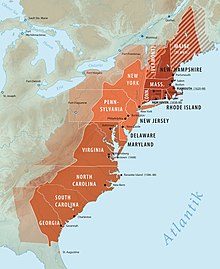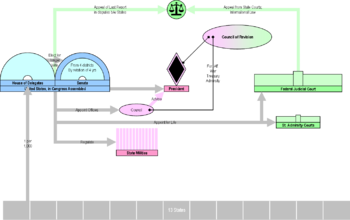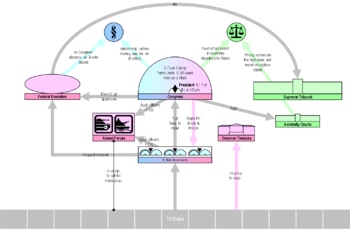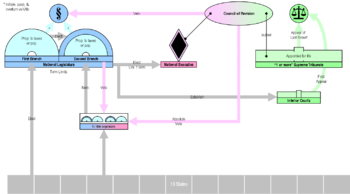Constitutional Convention (United States)
The United States Constitutional Convention (or Philadelphia Convention) met from May 25 to September 17, 1787, at the Pennsylvania State House in Philadelphia. The Convention drafted the Constitution of the United States, which is still in effect today.
The convention elected as its chairman George Washington of Virginia, the former commanding general of the Continental Army in the American War of Independence (1770-1783) and a proponent of a strong national government. The original mandate to the Convention had been to reform the system of government of the thirteen founding states as set forth in the Articles of Confederation. From the beginning, however, delegates such as James Madison of Virginia and Alexander Hamilton of New York knew that an entirely new constitution would have to be created.
Several models were proposed and discussed, including James Madison's Virginia Plan and William Paterson's New Jersey Plan. From the beginning, the delegates were largely in agreement that the new federal government should be structured according to the principles of separation of powers, consisting of legislative, executive, and judicial branches. There was also widespread agreement on the tasks of each arm. In contrast, the following questions were debated intensively and in opposition to each other:
- Composition and election procedures of the Senate as the legislative upper house in the bicameral system of Congress;
- Establish "proportional representation" based on area or population of a state, include slaves in population;
- Exercise of executive power by a committee of three or by a single supreme executive, the president;
- Election procedures, terms of office, number of presidential terms; possible grounds for impeachment;
- Election of judges by the legislative or executive branch;
- regulation concerning fugitive slaves, and the admissibility of an abolition of the slave trade.
By mid-July, agreement had been reached in the Connecticut Compromise to the extent that a Committee of Detail was appointed on July 24, 1787, to prepare a first detailed draft of the Constitution. Until this was available, the Convention adjourned. From 6 August onwards, further matters of detail were debated until a Committee on Style was able to draw up the final version in early September. After the Convention vote, the final text was written down on parchment and signed by 39 of the 55 delegates on September 17, 1787. Public debate then began over ratification in the individual states.

The thirteen founding states (areas added later colored lighter).

Scene at the signing of the United States Constitution. Painting by Howard Chandler Christy, 1940
Previous story
Weakness of the Confederate Congress
In 1787, approximately 4 million people lived in the territory of the 13 independent states. The basis of the joint government was the Articles of Confederation and Perpetual Union established by the Second Continental Congress, which had been proposed in 1776, passed in the Continental Congress in 1778, but not ratified by all the states until 1781. It quickly became apparent that the Confederation Congress was incapable of settling the conflicts that arose between individual states. According to Article 13 of the Articles of Confederation, they could only be changed by unanimous vote, which gave each individual state the right to veto. Since the Confederation Congress itself was not allowed to levy taxes and had no ability to claim payment from the states, its political room for maneuver was narrow.
Emerging conflicts between individual states
After independence was secured in the Revolutionary War (1775-1783), the interests of the individual states developed in different directions, disputes arose: Maryland and Virginia fought over their border on the Potomac River. When Rhode Island levied taxes on through traffic over the Boston Post Road, James Madison proposed that the state governments appoint commissioners of internal commerce to consider a uniform system of trade. Another occasion for calls for reform was Shays's Rebellion in Massachusetts, a violent conflict over tax debts that lasted from 1786 to 1787. In this context, the demand arose for a federal army that would maintain the peace and could also defend the Union externally.
Annapolis Convention
From September 11-14, 1786, twelve delegates from five U.S. states met in Annapolis, Maryland, for the Annapolis Convention to discuss improvements to the Articles of Confederation. Among them were James Madison and Alexander Hamilton. The delegates were charged with discussing interstate commerce. New Jersey's representatives were further empowered to address broader reforms. It was quickly realized that commerce could not be considered in isolation, and in the final report to the Confederate Congress, they recommended that a convention meet at the Pennsylvania State House in May of the following year, at which all the states would be represented.
The debate in detail
Several drafts of the Constitution were discussed during the Convention. The most important basis for discussion was the Virginia Plan prepared by Madison. Other drafts included a proposal introduced by Charles Pinckney, and, as the Convention progressed, the New Jersey Plan, which again moved closer to the Articles of Confederation. Alexander Hamilton introduced his own proposal, which the delegates felt was too close to a monarchy because of the lifetime presidential term it proposed. There is uncertainty among historians as to whether Hamilton's proposal was serious or more tactical to help Madison's more balanced Virginia plan gain traction. Delegates from Connecticut proposed the Connecticut Compromise, which - after some adjustments by Benjamin Franklin in favor of the larger states - was decisive in bringing about the draft constitution.
Virginia Plan
→ Main article: Virginia Plan
Prior to the start of the Convention, Virginia legislators met and, under Madison's direction, drafted a constitution that became known as the Virginia Plan or the Great States Plan. For this reason, Madison is also called the "Father of the Constitution." On May 29, 1787, Virginia Governor Edmund Randolph introduced the draft, which provided for a very powerful bicameral legislature. Both chambers would be filled proportionally. The lower house was to be directly elected by the people, and the upper house in turn by the lower house. The sole function of the executive was to be to carry out the directives of the legislature and was therefore to be appointed by the legislature. The Virginia Plan also provided for a judicial branch. The executive and parts of the judiciary were to hold a veto, but could be overruled.
New Jersey Plan
→ Main article: New Jersey Plan
After the Virginia Plan was introduced into debate, Representative for New Jersey, William Paterson moved to adjourn the session to allow sufficient time to understand the plan. Under the Articles of Confederation, all states were represented in Congress by an equal number of delegates and each possessed only one vote. By allocating seats in both houses of the legislature in proportion to population under the Virginia Plan, the smaller states found themselves at a disadvantage. Therefore, on June 14 and 15, representatives of the small states drew up the New Jersey Plan or the Small States Plan.
On June 15, Paterson presented the New Jersey Plan to the Convention. Ultimately a counter-proposal to the Virginia Plan, it was much closer to the Convention's original mandate, which was to amend the Articles of Confederation in a way that would solve existing problems. Under the New Jersey Plan, the Continental Congress was to remain in place but be given new powers, such as the right to levy and collect taxes. An executive branch was to be created, elected by Congress and consisting of several people. Members of the executive were to serve only one term and could be removed at any time by the governor of their state. In contrast, members of the judicial branch appointed by the executive were to serve for life. Finally, law enacted by Congress should be able to break state law. In the vote, the Convention opposed the New Jersey plan, but the smaller states now possessed a common position to which they could appeal.
Hamilton's proposal
On June 18, 1787, Hamilton presented his own design. It was also called the "British Plan" because it was close to the political system of Britain with its strong central government. Hamilton advocated the abolition of the sovereignty of the individual states in favor of a single nation. His model called for a bicameral legislature with the lower house elected by popular vote every three years. Electors chosen by the people were to elect members of the upper house for life. The plan also provided that the Governor of the Union (the head of the executive) was to be elected for life by electors and given an absolute veto. State governors would be appointed by the national legislature, which would also have veto power over laws enacted by the states. Because of its closeness to the British political system and the extensive limitation of the powers of the individual states, Hamilton's proposal did not find a majority in the Convention.
Pinckney's model
Immediately after Randolph presented the Virginia Plan, Charles Pinckney of South Carolina presented his own design to the Convention. Since he himself had not written down his ideas, Pinckney's model can only be inferred from Madison's notes. Pinckney proposed a Confederacy based on a treaty among the 13 states. This was to have a bicameral legislature with a Senate and a House of Representatives. In the latter, one representative was to represent each of one thousand inhabitants. The House of Representatives was to appoint the Senators, whose terms would be four years, each representing one of four regions. Both houses of Congress, in joint session, would elect the president and appoint the members of the cabinet. In the event of a dispute between individual states, Congress would serve as the final court of appeal; in addition, there would be a federal Supreme Court. Pinckney's plan was not discussed in the Convention, but probably influenced the work the Committee of Detail.
Connecticut Compromise
→ Main article: Connecticut Compromise
The Connecticut Compromise, which Roger Sherman of Connecticut was largely responsible for bringing about, was introduced in the Convention on June 11. It satisfies both the small (New Jersey plan) and the large states (Virginia plan). The most significant achievement is the allocation of seats in the Senate, which preserved the federal character of the Constitution: Sherman adopted the bicameral system of the Virginia plan, but proposed that seats in the lower house be allocated in proportion to the share of the (free) population, while in the Senate each state should have only one vote. The compromise was adopted on July 23.
In the end, a modified version of the compromise found its way into the Constitution: In the Grand Committee, Franklin prevailed upon Congress to enact laws affecting the national revenue. In the final version of the compromise bill to be voted on July 16, the Senate was still very much like the Continental Congress. For this reason, Madison, King, and Governor Morris strongly opposed the compromise. On July 23, just before most of what had been worked out in the Convention was to be turned over to the Committee of Detail, Morris and King moved that state representatives in the Senate be given individual voting rights rather than voting en bloc as in the Confederate Congress. Delegate Oliver Ellsworth of Connecticut, instrumental in bringing about the compromise, seconded the motion, which was then adopted by the Convention. Moreover, since the individually voting senators held significantly longer terms than the members of the state legislatures who appointed them, their fundamental independence was fixed. That all states received the same number of Senate seats strengthened the influence of the smaller states.

Pinckney Plan

New Jersey Plan

Virginia Plan

Hamilton Plan
Questions and Answers
Q: When and where was the Constitutional Convention held?
A: The Constitutional Convention was held from May 25 to September 17, 1787 in Philadelphia, Pennsylvania.
Q: What was the purpose of the Constitutional Convention?
A: Although the Convention was called to revise the Articles of Confederation, it became clear from the beginning that many members, including James Madison and Alexander Hamilton, intended to create a new government rather than fix the existing one.
Q: Who presided over the Constitutional Convention?
A: George Washington was elected to preside over the Convention.
Q: What was the result of the Constitutional Convention?
A: The result of the Convention was the creation of the United States Constitution.
Q: Why is the Constitutional Convention considered one of the most significant events in the history of the United States?
A: The creation of the United States Constitution at the Constitutional Convention is one of the most significant events in the history of the United States because it established the framework for the government that has lasted for over 200 years.
Q: What is another name for the Constitutional Convention?
A: The Constitutional Convention is also known as the Philadelphia Convention.
Q: Who were two important members of the Constitutional Convention?
A: James Madison and Alexander Hamilton were two important members of the Constitutional Convention who intended to create a new government rather than fix the existing one.
Search within the encyclopedia